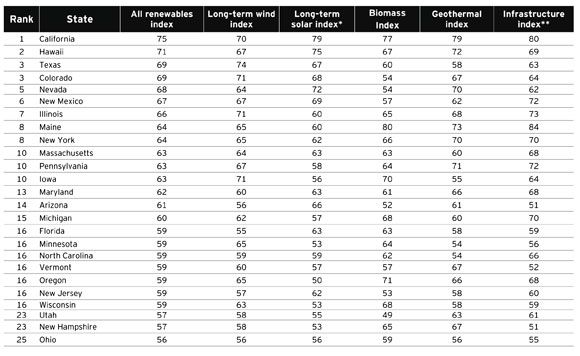Although clean energy investment was down in 2012, certain states are making considerable headway in installing renewable energy, according to a new index released by Ernst & Young.
The biannual renewable energy market attractiveness indices look at overall energy markets and individual technologies, providing scores out of 100. U.S. investment in clean energy was $44.2 billion in 2012, down from $65.4 billion in 2011. California continues to keep the top spot, with strong scores in solar and geothermal. Texas comes in third again, but a new state has jumped in between these two juggernauts: Hawaii.

Hawaii had something of a breakout year in solar PV installations in 2012. According to GTM Research, 36 megawatts of PV came on-line in the first quarter of 2012. There are 208 megawatts of cumulative PV solar installed across the HECO, HELCO, and MECO territories. GTM Research sees Hawaii installing in excess of 150 megawatts this year, according to the 2012 U.S. Solar Market Insight report.
The move up in the rankings is unsurprising since Hawaii has a target to get 70 percent of its energy from “clean energy" by 2030, which the state defines as a combination of renewable energy and energy efficiency.
It should be noted that solar installations in Hawaii are starting to slow down as the grid gets more saturated, the market gets more crowded, permit costs rise and uncertainty grows over the future of state tax credits. This has lead some to worry that Hawaii has already peaked. (For more on the darkening skies over Hawaii, read Marco Mangelsdorf's story on the Honolulu Civil Beat website.)
However, Hawaii also has extremely high electricity prices due to its reliance on oil for electricity, making solar particularly attractive. Although the state's solar and wind tax credit may be capped or limited, some experts argue it’s not even needed.
Maine was another state that saw a big move into the top ten, landing at number eight with high rankings for biomass and geothermal. “Growth in these industries has been modest,” the authors note, “but the consistency of the power generation is starting to be recognized as a benefit when compared with the intermittency of wind and solar.”
Despite its intermittence, wind still led the way in 2012, adding 13,124 megawatts of capacity and representing 41 percent of total renewable generation additions for the year.
Solar PV installations in the U.S. represented 11 percent of the global total, its highest share in recent years. Geothermal added just 77 megawatts of capacity last year.



